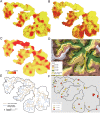Impact of environment and social gradient on Leptospira infection in urban slums
- PMID: 18431445
- PMCID: PMC2292260
- DOI: 10.1371/journal.pntd.0000228
Impact of environment and social gradient on Leptospira infection in urban slums
Abstract
Background: Leptospirosis has become an urban health problem as slum settlements have expanded worldwide. Efforts to identify interventions for urban leptospirosis have been hampered by the lack of population-based information on Leptospira transmission determinants. The aim of the study was to estimate the prevalence of Leptospira infection and identify risk factors for infection in the urban slum setting.
Methods and findings: We performed a community-based survey of 3,171 slum residents from Salvador, Brazil. Leptospira agglutinating antibodies were measured as a marker for prior infection. Poisson regression models evaluated the association between the presence of Leptospira antibodies and environmental attributes obtained from Geographical Information System surveys and indicators of socioeconomic status and exposures for individuals. Overall prevalence of Leptospira antibodies was 15.4% (95% confidence interval [CI], 14.0-16.8). Households of subjects with Leptospira antibodies clustered in squatter areas at the bottom of valleys. The risk of acquiring Leptospira antibodies was associated with household environmental factors such as residence in flood-risk regions with open sewers (prevalence ratio [PR] 1.42, 95% CI 1.14-1.75) and proximity to accumulated refuse (1.43, 1.04-1.88), sighting rats (1.32, 1.10-1.58), and the presence of chickens (1.26, 1.05-1.51). Furthermore, low income and black race (1.25, 1.03-1.50) were independent risk factors. An increase of US$1 per day in per capita household income was associated with an 11% (95% CI 5%-18%) decrease in infection risk.
Conclusions: Deficiencies in the sanitation infrastructure where slum inhabitants reside were found to be environmental sources of Leptospira transmission. Even after controlling for environmental factors, differences in socioeconomic status contributed to the risk of Leptospira infection, indicating that effective prevention of leptospirosis may need to address the social factors that produce unequal health outcomes among slum residents, in addition to improving sanitation.
Conflict of interest statement
The authors have declared that no competing interests exist.
Figures




References
-
- United Nations Human Settlements Programme. The challenge of slums: Global report on human settlements 2003. London: Earthscan Publications Ltd; 2003. p. 310.
-
- Sclar ED, Garau P, Carolini G. The 21st century health challenge of slums and cities. Lancet. 2005;365:901–903. - PubMed
-
- The General Assembly of United Nations. United Nations Millennium Declaration. 2000 Available: http://www.un.org/millennium/. Accessed 11 Mar 2008.
-
- Bartram J, Lewis K, Lenton R, Wright A. Focusing on improved water and sanitation for health. Lancet. 2005;365:810–812. - PubMed
Publication types
MeSH terms
Substances
Grants and funding
LinkOut - more resources
Full Text Sources
Research Materials

